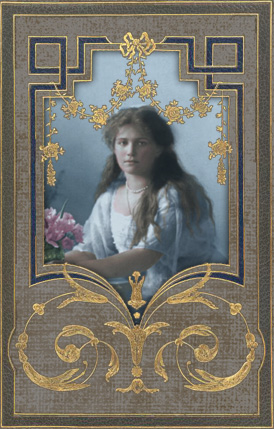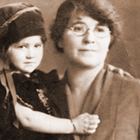Learn about the latest in color trends to keep your home, wardrobe, and website current and fresh.







CHAPTER 19
CHERSONESE
ON our way to the Crimea in the autumn of 1902 we passed the spot where the Imperial train was wrecked some sixteen or seventeen years ago.
A church has been erected, and the Emperor and Empress, with the little Grand Duchess Olga, attended divine service there. Many curious stories of hair-breadth escapes from death have been told me concerning this accident.
Electricity was used for the first time in the Imperial train on this journey. The train got most uncomfortably hot, and the Empress thought there was something wrong with the electrical engines, so she sent for the engineer and asked him to see why the train was so hot.
Taking his assistant with him he went into the engine-room; it was very hot there, and both men soon laid aside their coats and worked in their shirt-sleeves.
It was still too hot, and in spite of the remonstrance of his assistant, the engineer opened the window. In another moment the first shock of the explosion, or whatever wrecked the train was felt, and the two men were sent flying out of the window and down the slope. They fell about thirty feet, and arrived unhurt in the snow.
But many were killed and wounded; in one compartment two officers had put their swords in the netting over their heads. The swords fell out of the sheathes and struck them on the backs of their heads, killing them outright. The Secretary was precipitated through the window, and falling on his head, turned over and broke his neck.
The Imperial family were at luncheon when it occurred. The servant was just handing a dish of calves' brains to the Emperor when suddenly the shock threw them all to the ground. Most of them, including the present Emperor, found themselves under the table.
The Emperor was the first to recover; he was shocked to see the servant lying apparently dead, his face covered with blood and brains, and exclaimed with horror, " Oh! poor fellow! his brains are dashed out." The supposed corpse sat up and began to speak; he had cut his head in the fall and the brains were not his, but those of the calf.
The little Grand Duchess Olga Alexandrovna was thrown, with her nurse, through the window. They were both cut and bruised and the nurse sustained internal injuries, but nothing very serious; it was a wonderful escape. In all, about thirty people lost their lives, but none of the Imperial family were seriously injured.
Some say it was the work of anarchists. If so, they selected their spot with a care and ingenuity worthy of a better cause, as just in that place the ground dips and falls about thirty feet downwards from the railway. For miles on each side the track is perfectly level.
Others say that the lines had spread and so the train was turned over. Less than an hour before the pilot train, carrying most of the suite, had passed over in perfect safety.
We lay at anchor several days in Sevastopol harbour, and made several excursions to the town and adjacent country.
A battleship for the Black Sea Squadron was launched while we were there. Every night the harbour and fleet were illuminated and looked most beautiful. The children were delighted with the appearance of the ships and greatly puzzled as to how it was done.
However, we got to Sevastopol safely. The town is situated on high cliffs, and looks inaccessible from the water side; it is very open at the rear. The town still bears marks of the siege. It is all paved with cobble stones and is the noisiest place in the world for its area, I feel sure. It is picturesque. We were there early in October and the heat was intolerable. No rain falls during the summer months, and everything looks dried and choked with dust.
We passed through the famous quarries -- where the English lay entrenched and so much desperate fighting took place. Beyond these quarries are the graveyards where lie the victims, or some of them, of the war.
To understand something of the horrors of war we should visit, in cold blood the battle-fields, and see the graves of the fallen, and then count up as far as possible profits and losses. I feel sure that the vote would be given against the waste of human lives.
We visited the English graveyard. The piece of ground was bought from Russia and is enclosed with a stone wall, the entrance is handsome, and the whole place is kept in beautiful order. There is a resident caretaker, a Russian, who keeps all trim, and plants and tends flowers and shrubs with great care. Parts of the walls are festooned with clematis and plumbago, which flourish exceedingly. In the spring the Judas tree is a mass of purple blossoms. Humbler flowers, such as snapdragon, scabius, cornflowers, etc., grow on the graves. But those graves! The inscriptions on them are sad beyond belief.
A black marble slab bore the name of a young woman, and underneath that of a three days old baby, evidently her son, but nothing more to tell whose daughter and wife she had been, nor under what circumstances she had come out to perish at twenty-one years of age with her infant son in a far land, amid the strain and stress of war.
One stone covers the remains of four youthful officers. The inscription sets out that though unrelated, and in different regiments, they were bound together by their youth, heroism, and love of country. They fell in one battle and were buried in one grave. Their ages were from seventeen to twenty-one years, united they would not have been eighty. Poor boys! Who can tell how many hopes and fears, ambition, and love lie buried with them.
In one grave lie the remains of over four hundred men who fell together. I found the grave of a hero of whom I had read much in my youthful days, Captain Headley Vicars. He lies with his head to the wall; his grave is well kept. He was only twenty-seven years of age. In so short a life we would have thought there was little room for distinction, but his name will long be remembered for his great piety. "He rests from his labours, and his works do follow him." He was killed in the quarries one night.
On the other side of Sevastopol lies Chersonese, the lately excavated city. It was founded in the fourth century and was burned in the fourteenth by a horde of warlike Tartars. Some years ago something was dug up on the property of a local gentleman which led him to believe that the buried city lay under his property. Excavations were began and were crowned with victory. They found the remains of what was the chief street of the city. Portions of the houses remained and human remains lay about in all directions. They gathered these ghastly things and buried them. In many of the houses cooking operations had evidently been going on when sudden death overtook the inhabitants. There were many burned and charred loaves of bread taken from the ovens. There are also five eggs quite intact which were found in one of the houses. Fancy eggs more than five hundred years old!
There is a great deal of beautiful cut stone work; also various articles of pottery and glass. Many of the specimens look like old-fashioned silver lustre. Some of the articles are very graceful in shape.
There is also gold and silver jewellery set with precious stones and some precious stones, chains, brooches, and long, heavy ear-rings, also bracelets. Many of these were set with turquoise which had kept their colour wonderfully well.
The jawbone of a woman had each tooth filed to a point. The owner of it must have been a person of consideration in her own circles, for though they found hundreds of jawbones this was the only one with the teeth so decorated. Or perhaps she was the first to adopt a new fashion in teeth and the other ladies of Chersonese were waiting to .see what their lords and masters thought of it before taking to it. I should suppose she would have suffered terribly from toothache. One thing that struck me about the jaw was its exceeding smallness.
In one of the houses papers were found containing, amongst other valuable information, a plan of the city, and of the church, which had been excavated just before our visit.
The church was surrounded by four wells, north, south, east, and west. The water in three of them was brackish and bitter, that in the fourth was sweet and good for drinking. There were catacombs underneath the church and the mosaic on the floor of the church was described at length.
A few days before we visited the place the fourth well had been discovered. The three others had been discovered some little time before, and all three contained brackish water, but the fourth was sweet and quite good for use. There was great excitement about it, but nothing on earth would induce me to drink it, nor to allow the children to do so; I am not fond of trying experiments, and should not like to drink water which had been shut up for five hundred years.
Some of our party went down to see the catacombs, and one of them kicked over a skull, but I preferred to remain in the sunlight of the upper world. They found quantities of human remains there. The stairs leading down to them are in good repair.
The walls of the church stand to about the height of four feet, and have been strongly cemented on the top to try to keep them together. In one end of the church there is built into the fabric a semi-circular seat where the priests used to sit; it would hold twelve comfortably, but the floor is in beautiful repair. The mosaics are most extraordinary; there are patterns of birds, chalices, crosses, etc., all linked into a harmonious whole and all executed with the common pebbles from the sea-shore. They were rubbed and polished by the feet and knees of dead and gone worshippers.
The church is cruciform in shape. Tradition says it was built by Vladimir, the first Christian ruler of Russia, to commemorate his baptism which took place in a little chapel which had been incorporated into a monastery built on the top of a hill at a little distance off.
In the Winter Palace is a picture of the heads of Vladimir, Peter the Great, and Alexander II., joined together in the one painting, because they gave the three great gifts of Christianity, civilisation, and freedom to their country.
The gentleman who had carried out these most interesting excavations came down to see the Imperial children, and showed them all the Museum. He afterwards congratulated me most earnestly; he said he had never seen such young children take so intelligent an interest in antiquities, and he was sure I must often have talked to them on such subjects, etc. Had he only known it was their good manners he also ought to have admired, as the poor little ones did not understand much of what they heard. For one thing they were too young, and for another, in deference to me, he spoke in French.
That year in the Crimea we saw a great deal of Princess Ellen, now of Servia. She was a very sweet-faced though plain girl, with beautiful dark eyes, very quiet and amiable in manner. The little Grand Duchess Olga was very fond of her, and Princess Ellen would often come to tea in the nurseries, her young aunt, Princess Vera of Montenegro, and the young cousins with whom she lived most of the time. Princess Ellen was about seventeen years of age. Her mother had been dead for many years and she lived chiefly with one or other of the aunts in Russia. What a change has come into her life! I often think of her with deep pity and compassion. She can never know an easy moment, surrounded as she is by the assassins of the late king and queen. Poor, gentle, amiable girl! What will be her fate?
The Shah of Persia sent his conjuror over to the Emperor that year, and he performed for the children, who gave a large party of their friends, including Princess Ellen, to see him. He was really a most wonderful performer and did many extraordinary tricks. We had placed all the little ones in the front row and when he produced a pair of live pigeons from a pudding their joy knew no bounds. He presently produced a guinea pig, passed his hand over it, and lo! there were two in his hands. In a moment three little girls were on the platform, and eager voices cried, ÒOh! please, Mr. Conjuror, make me a guinea-pig for myself." My three eldest charges attacked him with beseeching eyes and hands. I verily believe he would have given them his trained guinea pigs, but I ran and stopped him, telling the children that the little animals were so fond of their master, and would be unhappy if taken away, I managed to get them into the hall again.
The nights in the Crimea are usually dark, and the roads exceedingly bad, so when we went out to tea our carriage was always preceded by a common cart, in which were tar barrels and torches to light us. The roads, many of which went up frightful mountains, are most unsafe.
The season of 1903 was exceptionally brilliant; the great event was the famous costume ball which was given in the old part of the palace, and at the request of the various Embassies was repeated in the new part.
All present were arrayed in the costumes worn at the court of the Emperor Alexis, father of Peter the Great. The Empress went dressed as his first wife, and her ladies-in-waiting copied their dresses from pictures of costumes worn by the belles of his court. The Empress's dress was indeed magnificent. It was in cloth of gold embroidered in pearl beads. The whole front of it was encrusted with precious stones, and had ropes of pearls down the sides. She wore her emeralds with it, and had a crown made especially for the occasion, decorated with emeralds.
Her dress and jewels cost upwards of a million roubles, more than a hundred thousand pounds of our money. It was, however, tremendously heavy and hot. The married ladies all wore the hair covered with a cloth resembling an embroidered napkin; the unmarried showed their hair. A very busy man was the coiffeur who dressed the hair, adding to the ladies' own tresses, curls or plaits.
Men's dress must have been most gorgeous in those days. Count Benkendorff, the Mareshal de la Cour, wore white satin tunic and knee-breeches trimmed with ermine, surmounted by a black velvet cape with a fur collar, and a small black velvet hat bound with ermine. He looked very well and exceedingly dignified. A couple of men came as falconers in doublets and hose and wearing yellow top-boots very much turned up at the toes. They had falcons chained to their wrists. Not a few were in chain armour. It was the gayest scene I have ever seen. They danced old-fashioned Russian dances which tell by gestures a story of courtship. The lady first pretends not to see her humble adoring swain, coming round by degrees, till finally they dance together, and walk up and down the hall, hand in hand, he evidently very pleased of his victory over the coy maiden, and she looking very demure and modest.



